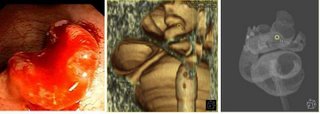There is some controversy as to what is the exact rate of completion of conventional colonoscopy. Virtual colonoscopy is extremely useful if performed preferably the same day as a failed colonoscopy. The colon is already cleaned, and the proximal colon is usually very well distended on the virtual exam. The exam is much easier to perform than a double contrast barium enema and it has been well established that virtual colonsocopy is more accurate than barium enema.
What is the virtual colonoscopy volume that one may expect from those incomplete colonoscopies?
A recent study published in the New England Journal of Medicine Nov 2006 included 50,148 participants who underwent screening.
The cecal intubation rate/completion rate was 91.1%.
It was somewhat lower than expected for expert colonoscopists. However, the screening colonoscopy program is a large-scale operation that cannot be limited to expert centers (only about one quarter of the 40 centers involved in the study would have been considered expert). Consequently, a less-than-expert rate of intubation probably has to be accepted in a mass-screening setting. Bowel preparation was sufficient, good, or very good for 91.9% of participants.
It is also our experience that in an expert center completion rates approach 96%.
A high volume expert endoscopy center may refer at least 4-5 patients a week for virtual colonoscopy.
Colonoscopy in Colorectal-Cancer Screening for Detection of Advanced NeoplasiaRegula J., Rupinski M., Kraszewska E., Polkowski M., Pachlewski J., Orlowska J., Nowacki M. P., Butruk E. N Engl J Med 2006; 355:1863-1872, Nov 2, 2006







